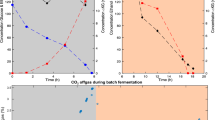Abstract
The efficiency of carbon conversion to biomass and desirable end products in industrial fermentations is diminished by the diversion of carbon to acetate and lactate excretions. In this study, the use of prototrophic and mutant strains of Escherichia coli, as well as enzyme active site directed inhibitors, revealed that flux to acetate excretion is physiologically advantageous to the organism as it facilitates a faster growth rate (μ) and permits growth to high cell densities. Moreover, the abolition of flux to acetate excretion was balanced by the excretion of lactate as well as 2-oxoglutarate, isocitrate and citrate, suggesting a ‘bottle-neck’ effect at the level of 2-oxoglutarate in the Krebs cycle. It is proposed that the acetate excreting enzymes, phosphotransacetylase and acetate kinase, constitute an anaplerotic loop or by-pass, the primary function of which is to replenish the Krebs cycle with reduced CoA, thus relieving the bottle-neck effect at the level of 2-oxoglutarate dehydrogenase. Furthermore, flux to lactate excretion plays a central role in regenerating proton gradient and maintaining the redox balance within the cell. The long-held view that flux to acetate and lactate excretions is merely a function of an ‘over-flow’ in central metabolism should, therefore, be re-evaluated.




Similar content being viewed by others
References
Aristidou AA, San K-Y, Bennett GN (1994) Modification of central pathways in Escherichia coli to reduce acetate accumulation by heterologous expression of the Bacillus subtilis acetolactate synthase gene. Biotechnol Bioeng 44:944–951
Bauer K, Bassat AB, Dawson M, De La Puente VT, Neway JO (1990) Improved expression of human interleukin-2 in high-cell-density cultures of Escherichia coli K-12 by a phosphotransacetylase mutant. Appl Environ Microbiol 56:1296–1302
Chin AM, Feldheim DA, Saier MH Jr (1987) Evidence for regulation of gluconeogenesis by the fructose phosphotransferase system in Salmonella typhimurium. J Bacteriol 169:897–899
Contiero J, Beaty C, Kumari S, DeSanti CL, Strohl WR, Wolfe A (2000) Effect of mutations in acetate metabolism on high-cell-density growth of Escherichia coli. J Ind Microbiol Biotechnol 24:421–430
Cortay JC, Neger D, Scarabel M, Ramseier TM, Vertak NB, Reizer J, Saier MH Jr, Cozzone AJ (1994) In vitro asymmetric binding of the pleiotropic regulatory protein, FruR, to the ace operator controlling the glyoxylate shunt enzymes synthesis. J Biol Chem 269:14885–14891
Diaz-Ricci JC, Tsu M, Bailey JE (1992) Influence of expression of the pet operon on intracellular metabolic fluxes of Escherichia coli. Biotechnol Bioeng 39:59–65
Dobzansky TH (1973) Nothing in biology makes sense except in the light of evolution. Am Biol Teach 35:125–128
El-Mansi EMT (1997) Diversion of carbon flux from central metabolism to product formation. Soc Gen Microbiol Symp 145:17
El-Mansi EMT (1998) Control of metabolic interconversion of isocitrate dehydrogenase between the catalytically active and inactive forms in Escherichia coli. FEMS Microbiol Lett 166:333–339
El-Mansi EMT, Holms WH (1989) Control of carbon flux to acetate excretion during growth of Escherichia coli in batch and continuous cultures. J Gen Microbiol 135:2875–2883
Gottschal JC, Morris JG (1981) The induction of acetone and butanol production in cultures of Clostridium acetobutylicum by elevated concentration of acetate and butyrate. FEMS Microbiol Lett 12:38–89
Han K, Lim HC, Hong J (1992) Acetic acid formation in Escherichia coli fermentation. Biotechnol Bioeng 39:663–671
Holms WH (1986) The central metabolic pathways of Escherichia coli: relationship between flux and control at a branch point, efficiency of conversion to biomass and excretion to acetate. Curr Top Cell Regul 28:59–105
Kleman GL, Strol WR (1994) Acetate metabolism by Escherichia coli in high cell density fermentation. Appl Environ Microbiol 60:3952–3958
Luli GW, Strohl WR (1990) Comparison of growth, acetate production and acetate inhibition of Escherichia coli strains in batch and fed-batch fermentations. Appl Environ Microbiol 56:1004–1011
Postoma PW, Lengeler JW, Jacobson GR (1993) Phosphoenolpyruvate: carbohydrate phosphotransferase systems in bacteria. Microbiol Rev 57:543–594
San K-Y, Bennett GN, Berrios-Rivera SJ, Vadali RV, Yang Y-T, Horton E, Rudolph FB, Sariyar B, Blackwood K (2002) Metabolic engineering through cofactor manipulation and its effect on metabolic flux redistribution in Escherichia coli. Methods Eng 4:182–192
Varma A, Palson BO (1994) Stoichiometric flux balance models quantitatively predict growth and metabolic by-product excretion in wild-type Escherichia coli W3110. Appl Environ Microbiol 60:3724–3731
Xu B, Jahic M, Enfors S-O (1999) Modeling of overflow metabolism in batch and fed-batch cultures of Escherichia coli Biotechnol Prog 15:81–90
Yang S, Enfors S-O (1996) Process conditions affecting proteolysis of recombinant proteins in Escherichia coli. Biotechnol Lett 18:7–12
Yang Y-T, Aristidou AA, San K-Y, Bennett GN (1999) Metabolic flux analysis of Escherichia coli deficient in the acetate production pathway and expressing the Bacillus subtilis acetolactate synthase. Methods Eng 1:26–34
Yee L, Blanch HW (1992) Recombinant protein expression in high cell density fed-batch culture of Escherichia coli. Biotechnology 10:1550–1556
Acknowledgements
The author wishes to thank Dr. David Mousdale for expert advice on HPLC and Miss Marina Mocogni for skilled technical assistance in the preparation of the manuscript. The author wishes to pay tribute to the late W.H. Holms for many helpful and stimulating discussions.
Author information
Authors and Affiliations
Corresponding author
Rights and permissions
About this article
Cite this article
El-Mansi, M. Flux to acetate and lactate excretions in industrial fermentations: physiological and biochemical implications. J IND MICROBIOL BIOTECHNOL 31, 295–300 (2004). https://doi.org/10.1007/s10295-004-0149-2
Received:
Accepted:
Published:
Issue Date:
DOI: https://doi.org/10.1007/s10295-004-0149-2




